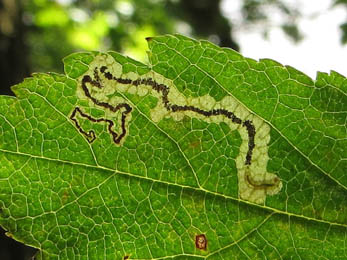|
||||||
|
COTONEASTER. Cotoneasters. [Rosaceae] |
|
|
Ninety-four species and subspecies of Cotoneaster are recorded in Britain. These include the native Wild Cotoneaster (C. cambricus). The BSBI provide a downloadable plant crib for Cotoneaster. Twenty-seven British miners are recorded on Cotoneaster. A key to the European miners recorded on Cotoneaster is provided in Bladmineerders van Europa. |
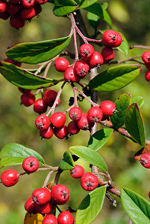 Cotoneaster Cotoneaster sp. |
|
Key for the identification of the known mines of British |
1a > Leaf-miner and case-bearer: The larva lives outside the mine, protected by a case, and feeds on the underlying plant tissues via a hole cut in the epidermis. From that point it eats away as much leaf tissue as it can reach without fully entering the mine. Mine does not contain frass (Coleophora species) |
1b > Leaf-miner, but not a case-bearer: The larva lives mainly inside the mine. Mine usually contains frass. In later instars the larva may live sandwiched between two more or less circular sections cut from the leaf. |
2a > Leaf-miner and case-bearer: The larva initially makes a blotch mine in the leaf, which it then excises to form its case. The larva overwinters in its case before resuming feeding in spring. A new case, 6-7 mm long, is then constructed from a further blotch mine. The second case is indistinguishable from C. spinella and C.prunifoliae. The final case is a tubular leaf case, 6-7 mm long, light brown at first, darker later. The rear end is trivalved, the mouth opening is around 45°. The larvae live at the underside of the leaves, and make sizable full depth mines. |
|
Coleophora coracipennella (Hübner, 1796) [Lepidoptera: Coleophoridae]. |
2b > Leaf-miner and case-bearer: The species spends two years as a larva, the first one-and-a-half years in a small pistol-case, and in the second spring building a long straight case which is dark brown and rather distinctive. The lava lives from autumn until summer next year. In autumn a composite leaf case is made, shaped like the handle of a walking stick. Early in the following spring a tubular leaf case is made that in the end is rather large (10 mm) and is positioned vertically on the leaf; mouth angle 90°. |
|
Coleophora hemerobiella (Scopoli, 1763) [Lepidoptera: Coleophoridae]. |
2c > Leaf-miner and case-bearer: Tubular leaf case, 6-7 mm long, light, later dark brown, trivalved, with a mouth angle of 45°. The larva lives at the underside of the leaf, and makes sizable full depth mines there. |
|
Coleophora prunifoliae Doets, 1944 [Lepidoptera: Coleophoridae]. |
2d > Leaf-miner and case-bearer: The larva feeds by inserting its head into small mines it creates on the leaves of birch, elm, alder, or hazel. Occasionally it is found feeding on other trees, or on herbaceous plants onto which it has accidentally Fallén. It forms two cases during its larval life. The first case is initially curved, smooth, laterally compressed with a bivalved anal opening, and about 2 mm long in September. During October it feeds, and adds a few rough collars of larval material around the oral opening. After hibernation, it feeds again in April and early May, adding more protruding collars until they equal or exceed the original smooth part of the case. At the same time, it expands the case girth by the creation of a silk gusset ventrally. The second case, 6 or 7 mm long, is formed in May, leaving the vacated first case attached to its last feeding mine. The new case is tubular with a trivalved crimp at the anal opening. The dorsum is formed from the edge of the leaf from which the case was cut. This results in a more or less serrated dorsal keel, depending on the plant species and the individual piece of leaf used. Considerable variation in the degree of serration can be found, even among specimens off the same tree. The case colour varies with food plant, from yellowish brown on birch, darkening through elm and hazel to dark brown on alder. The strongly curved young case is is a composite leaf case, the adult case is a tubular leaf case. The adult case is bivalved, about 7 mm in length; the mouth angle is around 30°. The case is straw coloured and almost always has a toothed dorsal keel (remnant of the margin of the leaf from which the case was cut). Neither larvae or cases of C. coracipennella, prunifoliae, serratella and spinella can be separated; from serratella. |
|
Coleophora serratella (Linnaeus, 1761) [Lepidoptera: Coleophoridae]. |
2e > Leaf-miner and case-bearer: Larva in autumn forming a few small mines. Feeding restarts in the same case in spring before changing to a new case by late April. In spring the cases or mines cannot be reliably separated from those of C. coracipennella or C. prunifoliae. The larva lives two years. In the first year, in autumn, a composite leaf case is made that resembles a boomerang: front and rear end stand at almost right angles. In its second year the larva makes a trivalved tubular leaf case of about 6 mm, with a mouth angle of c. 45°; the case tapers somewhat to both ends. |
|
Coleophora spinella (Schrank, 1802) [Lepidoptera: Coleophoridae]. |
2f > Leaf-miner and case-bearer: Tubular silken case of only 5-6 mm. The case is weakly constricted near the anal end, and strongly just behind the mouth. The case is sharply bent there; therefore the mouth angle is 0° and the case lies adpressed to the leaf. The fully developed case normally is trivalved. Larvae at the underside of the leaf. |
|
Coleophora trigeminella Fuchs, 1881 [Lepidoptera: Coleophoridae]. |
3a > Leaf-miner: The larvae initially mining the leaves in a short, contorted gallery. As the larva develops it leaves the mine to feed externally, creating windows on the upperside of the leaves. Oviposition at the leaf upperside, egg shell iridescent. Small, hook-like corridor, mostly in a vein axil. Frass in a very thick central line. The larva soon leaves the mine through an untidy hole and subsequenty feeds living freely on the leaf. Pupation occurs in a ribbed white cocoon spun on debris. The winter is passed in this stage.. |
|
Bucculatrix bechsteinella (Bechstein & Scharfenberg, 1805) [Lepidoptera: Bucculatricidae]. |
3b > Leaf-miner: The young larvae mine the leaves, causing a gallery followed by a semi-translucent blotch on the upper surface of the leaf. It then vacates this and folds the edge of a leaf down to feed within, usually twice, before pupating externally among detritus. The mine begins as an inconspicuous epidermal corridor, mainly recognisable by its reddish brown frass line. In the next instar a blotch is formed. The mine not starting over a vein, rather lies between two veins. The colour initially is silvery, but soon the mine gets a characteristic onrange-brown tinge. Usually, but by no means invariably, the mine is upper-surface; lower-surface mines keep their original silvery colour. Silk is deposited witihin the mine, but in little quantities and the mine contracts only lightly. The mine hardly contains any frass. After some time the larva leaves the mine and then lives free in a leaf margin that has been folded downwards and fixed with silk. Two such folds are usually made, and eaten out to the upper epidermis. |
|
Callisto denticulella (Thunberg, 1794) [Lepidoptera: Gracillariidae]. |
3c > Leaf-miner: A circular or oval brownish blotch with a central spiral of dense blackish frass (British leafminers), sometimes several mines in one leaf. Oviposition is at the leaf underside, well away from the leaf margin; the egg has a fine reticulate surface. The mine is a rather large, perfectly circular blotch without a trace of a preceding corridor. Around the dark centre the frass, glued to the upper epidermis is arranged in distinct arcs. Pupation in a silken cocoon, usually on detritus. Pupation in a silken cocoon, usually on detritus. |
|
Leucoptera malifoliella (O. Costa, 1836) [Lepidoptera: Lyonetidae]. |
3d > Leaf-miner: A long, whitish smoothly-curved upper-surface mine with broken black frass. Oviposition is by means of an ovipositor; what remains is a small scar: no egg shell is visible at the start of the mine. From here a long, sometimes very long, slender, full depth corridor winds throught the leaf, not steered by leaf margin or the leaf venation. The midrib is crossed effortless; the corridor frequently also crosses itself; the section of the leaf cut off then usally turns brown and dies off. Frass in a narrow central line. The larva vacates the mine prior to pupation through an exit in the upper epidermis. The vacated larval chamber is proportionally much longer than in the case of Stigmella mines ( > 3 x longer than broad). Pupation in a silken cocoon suspended from threads attached to food plant or other vegetation. |
|
Lyonetia clerkella (Linnaeus, 1758) [Lepidoptera: Lyonetidae]. |
3e > Leaf-miner: The larva mines the leaves of various roseaceous trees, such as blackthorn and apple, forming a gallery leading to a blotch. Eggs are deposited in the underside of a leaf, well away from the margin, often several per leaf. Around the oviposition site a cavity develops that in the end often leaves a hole in the leaf. Then a narrow, hardly widening, winding corridor, largely filled with a broad reddish brown frass line. The corridor abruptly widens into a wide, full depth blotch, that often lies against the leaf margin. The larva may leave its mine and continue elsewere, even on a different leaf. Note that the first blotch may already lie on a different leaf. Frass dispersed, in oval granules. Most frass is ejected through semicircular cuts along the outer limit of the blotch; part of it is often trapped in strands of silk under the leaf. The pupal cocoon is suspended from silken 'guy ropes' and closely resembles that of L. clerkella. |
|
Lyonetia prunifoliella (Hübner, 1796) [Lepidoptera: Lyonetiidae]. |
3f > Leaf-miner: Before overwintering larvae make a small, full depth blotch (Robbins, 1991a). After hibernation, they live freely under a silk. Larvae mine in late autumn (Agassiz, 1996a). Not rare, in Belgium (De Prins, 1998a). |
|
Paraswammerdamia nebulella (Goeze, 1783) [Lepidoptera: Yponomeutidae]. |
3h > Leaf-miner: In a small Phyllonorycter-like mine initially, but with brown rather than green lower epidermis. Later in two or more successive cones formed by folding leaf-lobes downwards. The mine begins at a flat, iridescent egg shell. It starts as an epidermal corridor, widening into (and mostly over run by) a shallow lower surface blotch in the tip of a leaf segment. The lower epidermis is off-grey with small light brown spots at first, but soon turns brown. Silk is deposited within the mine, causing it to contract. This wrinkles the lower epidermis, but there are no clear folds formed. Soon the larva starts consuming the palissade parenchyma, and the upperside of the mine than turns brown as well. Frass in loose grains. After some time the larva leaves its mine and continues living free under a downfolded leaf segment, kept in place by some spinning. Here too the leaf tissue is consumed up to the palissade parenchyma, browning the leaf. |
|
Parornix anglicella (Stainton, 1850) [Lepidoptera: Gracillariidae]. |
3i > Leaf-miner: Early mine a blotch with lower and upper epidermis turning brown. Then either a fold at the leaf edge, or a mine resembling that of a Phyllonorycter, but formed by a silken pad on the underside. The mine begins with a lower-surface epidermal corridor, but soon the larva starts feeding on the sponge parenchyma. The mine then becomes a flat lower-surface blotch. Silk, deposited in the mine causes the lower epidermis to pucker ligtly. The lower (later also the upper) epidermis of the mine is greyish brown to brown. After leaving the mine the larva lives freely under a folded leaf margin, or in a fold at the underside of the leaf, in its centre, that is covered with silk. Larva greenish white; head light brown with a pair of brown spots. The full grown larva is remarkably slender, hyaline, with a large roundish black spot on the pronotum. The instar just before pupations lacks this spot. Larva and pupa are described by Lüders (1900a) and Grandi (1931a, 1933a). |
|
Parornix scoticella (Stainton, 1850) [Lepidoptera: Gracillariidae]. |
3j > Leaf-miner: The mine is in the upper epidermis of a leaf, usually over midrib or vein. The mine is at first silvery, later with brown speckling. Silvery, upper-surface, epidermal tentiform mine, centered over the midrib or a heavy lateral vein. Unlike P. leucographella, with which this species shares some host plants, the upper epidermis looks dirty by the presence of numerous fine black-brown specks of frass. The epidermis remains without folds until the mine becomes strongly contrated. Young mines look like a streak of silver on top of a vein. |
|
Phyllonorycter corylifoliella (Hübner, 1796) [Lepidoptera: Gracillariidae]. |
3k > Leaf-miner: The mine is upper side and silvery, over the midrib. Leaf later may fold upwards, concealing the mine. Oviposition is on the base of the midrib. From there an epidermal corridor is made, running towards the leaf tip. The corridor then is widened into an epidermal, silvery blotch, finally into a longitudinally contracted tentiform mine. Frass in fine, shining grains, mostly in a line over the midrib, rarely in a mass in a corner of the mine. The epidermis of the mine has a number of yellow spots, but never the black specks that are apparent in P. corylifoliella. |
|
Phyllonorycter leucographella (Zeller, 1850) [Lepidoptera: Gracillariidae]. |
3l > Leaf-miner: Lower-surfce, yellow-green tentiform mine, 20-32 mm long, with a number of fine folds in the lower epidermis. In most cases the mine is elongate, situated between two lateral veins. The reddish to chestnut brown pupa lies in a flimsy cocoon in which no frass is incorporated: the frass is stored not in a clump but in a row of loose grains behind the cocoon. Just before edcysis the pupa works itself out of the mine through the lower wall; mostly the empty exuvium sticks halfway out of the mine. |
|
|
Phyllonorycter mespilella (Hübner, 1805) [ Lepidoptera: Gracillariidae]. |
| 3m > Leaf-miner: A large mine with a strong crease in lower epidermis. Leaf-edge often folded downwards. Lower-surface, yellow-green tentiform mine with a few sharp folds in the epidermis. In Rowan the mine is parallel to the leaf margin, in Cherry usually between two lateral veins. The light brown cocoon lies in a wide cocoon, in which no frass is incorporated; all frass is accumulated in a clump in an angle of the mine. Before hatching the pupa penetrates the mine wall; generally the exuvium remains stuck halfway out of the mine. |
 Phyllonorycter sorbi pupa, cremaster, dorsal Image: © Willem Ellis (Bladmineerders van Europa) |
|
Phyllonorycter sorbi (Frey, 1885) [Lepidoptera: Gracillariidae]. |
3n > Leaf-miner: The young larva mines the leaves of its foodplant then hibernates. It will then mines leaves or flowerbuds, then blossom or leaves. Branched, sometimes stellate, brownish, very transparent, sometimes long corridor that contains no frass. All frass is ejected through a number of tiny openings that generally are close to a vein. Only the young larvae are miners. |
|
Recurvaria nanella (Denis & Schiffermüller, 1775) [Lepidoptera: Gelechiidae]. |
3o > Leaf-miner: Usually a very small (but see below), pear-shaped, upper-surface blotch, most of it stuffed with reddish brown frass. Often several mines in a leaf. Ovipisition is already in May, but the larvae hatch late and initially develop very slowly; only against the end of summer the mines become apparent. The larvae remain in the mine and hibernate in the fallen leaves. The bright-coloured frass and their large number makes these mines very conspicuous in autumn, despite their small size. The weevils feed pinhole-sized windows in the leaf upperside (maturation feeding). |
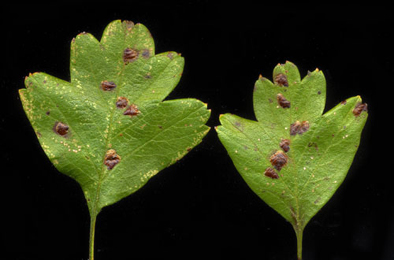 Minee of Rhamphus oxyacanthae on Crataegus monogyna Image: © Willem Ellis (Bladmineerders van Europa) |
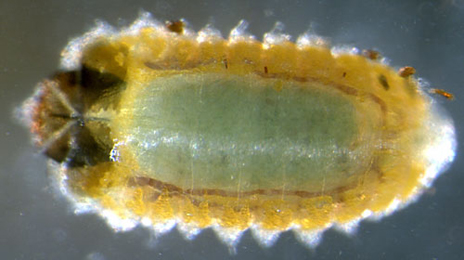 Rhamphus oxyacanthae larva, dorsal Image: © Willem Ellis (Bladmineerders van Europa) |
|
Rhamphus oxyacanthae (Marsham, 1802) [Coleoptera: Curculionidae]. |
3p > Leaf-mine: The young larvae make very small (≤ 3 mm) corridor or blotch mines, usually several in a leaf. The primary mine generally lies adjacent to the midrib; as far as I have seen the egg always is upper-surface. The secondary mines often are found in leaves without primary mine: obviously the larvae easily move to another leaf. The secondary mines are made from the underside of the leaf; while moving around silk is deposited under the leaf. Most frass is ejected from the mines, and part of the frass grains remain stuck in the spinning. Rather soon the larvae start living completely free in a common spinning under a leaf. They hibernate in a hibernaculum and continue living free in the spring. |
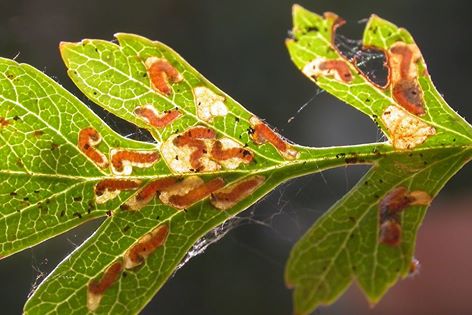 Mines of Scythropia crataegella on Crataegus Image: Ben Smart |
|
Scythropia crataegella (Linnaeus, 1767) [Lepidoptera: Yponomeutidae]. |
3q > Leaf-miner: The frass linear in early gallery, widening to blotch with dispersed frass. Oviposition at random point of the leaf, either at upper- or lower-surface. First a quite slender corridor is made, with a relatively broad, continuous, frass line, that always leaves a clear margin at either side; the corridor winds freely through the leaf. This initial corridor often abruptly changes in direction, widens into a blotch that mostly lie along the leaf margin. Pupation outside the mine. |
|
Stigmella hybnerella (Hübner, 1813) [Lepidoptera: Nepticulidae]. |
3r > Leaf-miner: A long thin linear gallery with frass in a thin line, sometimes broken. This distinguishes it form S.nylandriella, which never has linear frass throughout the mine. The gallery of S.magadalenae is also narrower than S.nylandriella. S. magdalenae can both be an edge miner or make a small mine in the leaf blade, or run along a vein. Egg at the underside of the leaf, independent of the venation. The corridor is narrow from start to end, and compressed on a small space, sometimes following the leaf margin for a while, more often along a major vein. Frass in a narrow, regularly interrupted central line. In thick leaves the frass line is broader, and the corridor is shorter. |
|
Stigmella magdalenae (Klimesch, 1950) [Lepidoptera: Nepticulidae]. |
3s> Leaf-miner: Rather short, full depth, gradually widening corridor, the last section suddenly widenened still a bit more into an elongated blotch. Frass in a central line, about 1/3 of the width of the corridor. Pupation outside the mine. |
|
|
Stigmella mespilicola (Frey, 1856) [Lepidoptera: Nepticulidae]. |
3t > Leaf-miner: The reddish frass is linear, later in arcs, finally dispersed. Long corridor, that widens only little, and winds freely through the leaf, not influenced by the venation. In thick, sun-exposed leaves the mine may be much shorter, especially in Cotoneaster, Malus and Pyrus. Frass brown, in arcs.. |
|
Stigmella oxyacanthella (Stainton, 1854) [Lepidoptera: Nepticulidae]. |
3u > Leaf-miner: A narrow gallery leads abruptly to large blotch. Oviposition on the leaf underside. The mine begins as a very slender winding corridor of 15-20 mm, the second part of which is almost stuffed with frass. The corridor abruptly widens into a blotch with dispersed frass; in large leaves this blotch is almost circular. Mostly the midrib is not crossed, but the mine can occupy the major part of a leaflet. Often several mines in leaf. |
|
Stigmella sorbi (Stainton, 1861) [Lepidoptera: Nepticulidae]. |
3v > Leaf miner. The egg is deposited in the base of the midrib. After oviposition the female severes the petiole, causing the petiole to break. The leaf start to wilt and falls, but still remains green for a considerable time. The larva tunnels in the midrib, and makes from there broad, full deep blotches in the lamina. Frass dispersed in the mine. Often several larvae in a leaf. Pupation in the ground. Blommers & Vaal (2002a) and Gønget (2003a) describe the biology in more detail.. |
On Crataegus, Mespilus and Prunus, but not yet on Cotoneaster, in Britain and Amelanchier, Cotoneaster, Crataegus, Cydonia, Malus, Prunus and Pyrus elsewhere. Recorded in several counties in southern Britain and widespread in continental Europe. |
Neocoenorrhinus pauxillus (Germar, 1824) [Coleoptera: Rhynchitidae] |
| Last updated 03-Jul-2019 Brian Pitkin | ||


